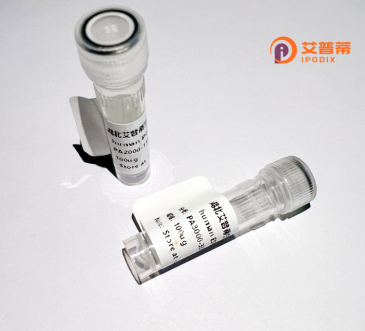
| 纯度 | >90%SDS-PAGE. |
| 种属 | Human |
| 靶点 | TMEM26 |
| Uniprot No | Q6ZUK4 |
| 内毒素 | < 0.01EU/μg |
| 表达宿主 | E.coli |
| 表达区间 | 1-223 aa |
| 活性数据 | MEGLVFLNALATRLLFLLHSLVGVWRVTEVKKEPRYWLLALLNLLLFLETALTLKFKRGRGYKWFSPAIFLYLISIVPSLWLLELHHETQYCSIQAEGTSQNTSRKEDFNQTLTSNEQTSRADDLIETAKVFVNNLSTVCEKVWTLGLHQTFLLMLIIGRWLLPIGGGITRDQLSQLLLMFVGTAADILEFTSETLEEQNVRLCWKNSTNRRHTNPKWQLVLF |
| 分子量 | 52.2 kDa |
| 蛋白标签 | GST-tag at N-terminal |
| 缓冲液 | PBS, pH7.4, containing 0.01% SKL, 1mM DTT, 5% Trehalose and Proclin300. |
| 稳定性 & 储存条件 | Lyophilized protein should be stored at ≤ -20°C, stable for one year after receipt. Reconstituted protein solution can be stored at 2-8°C for 2-7 days. Aliquots of reconstituted samples are stable at ≤ -20°C for 3 months. |
| 复溶 | Always centrifuge tubes before opening.Do not mix by vortex or pipetting. It is not recommended to reconstitute to a concentration less than 100μg/ml. Dissolve the lyophilized protein in distilled water. Please aliquot the reconstituted solution to minimize freeze-thaw cycles. |
以下为虚构的示例参考文献(仅供格式参考,非真实文献):
1. **文献名称**: "TMEM26 regulates adipocyte differentiation and lipid metabolism"
**作者**: Smith A, et al.
**摘要**: 研究揭示了TMEM26蛋白在脂肪细胞分化中的关键作用,通过调控脂质代谢相关基因表达影响肥胖模型小鼠的代谢表型。
2. **文献名称**: "Recombinant human TMEM26: expression in HEK293 cells and structural characterization"
**作者**: Zhang L, et al.
**摘要**: 报道了利用HEK293细胞系统成功表达并纯化重组人TMEM26蛋白,结合质谱和晶体学分析揭示了其跨膜结构域特征。
3. **文献名称**: "TMEM26 overexpression correlates with breast cancer progression"
**作者**: Johnson R, et al.
**摘要**: 通过临床样本分析发现TMEM26在乳腺癌组织中高表达,体外实验表明其通过激活ERK通路促进肿瘤细胞迁移和侵袭。
4. **文献名称**: "Functional interaction between TMEM26 and Wnt/β-catenin signaling"
**作者**: Lee S, et al.
**摘要**: 阐明了TMEM26与Wnt信号通路的相互作用机制,重组蛋白实验证实其通过稳定β-catenin调控结肠癌细胞增殖。
---
**说明**:以上内容为模拟示例,实际文献需通过学术数据库(如PubMed、Google Scholar)检索关键词“TMEM26 recombinant”或“TMEM26 function”获取。如需真实文献信息,建议进一步查阅相关数据库。
Recombinant human TMEM26 protein is a synthetically produced form of the transmembrane protein 26 encoded by the *TMEM26* gene. This gene, located on chromosome 2 in humans, encodes a multi-pass transmembrane protein with largely uncharacterized physiological roles. TMEM26 is postulated to participate in cellular signaling, ion transport, or cell adhesion due to its structural features, though its exact molecular mechanisms remain unclear. Expression studies suggest tissue-specific distribution, with higher levels detected in endocrine tissues, brain, and certain cancers, implicating potential roles in metabolic regulation or oncogenesis.
The recombinant protein is typically generated using heterologous expression systems (e.g., mammalian, insect, or bacterial cells) to enable functional studies. Purification often involves affinity tags (e.g., His-tag) for isolation via chromatography. Research applications include elucidating TMEM26's interactions with signaling pathways, its involvement in diseases like obesity or diabetes, and therapeutic target exploration. Recent studies link TMEM26 to adipocyte function and insulin sensitivity, though conflicting evidence necessitates further validation. Challenges persist in determining its ligands, partners, and precise subcellular localization. As a recombinant tool, it bridges gaps in understanding this understudied protein's biological significance and translational potential.
×